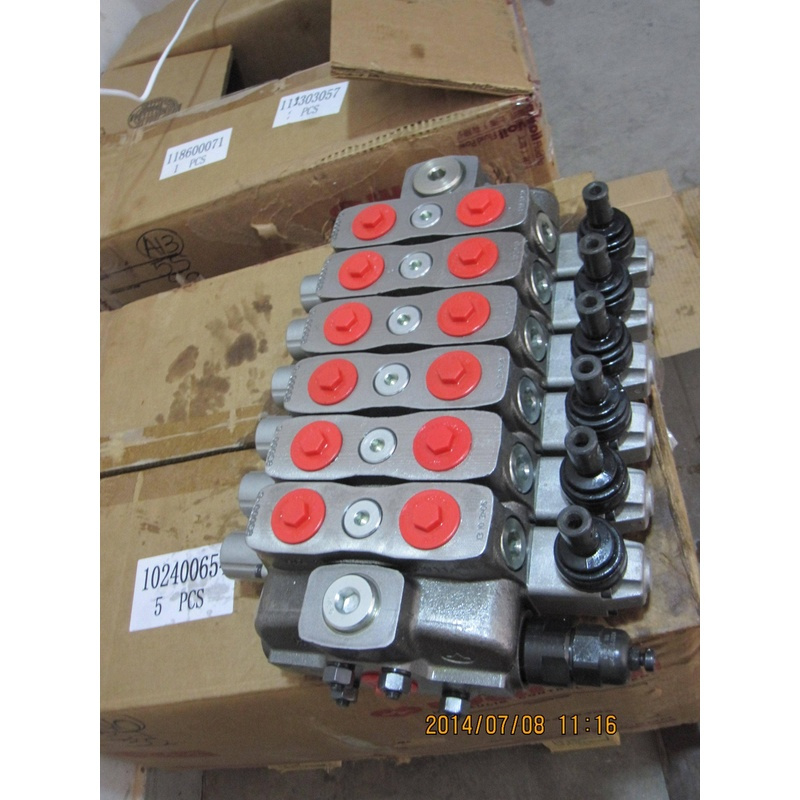The Walvoil SDS180/1 represents a key solution in the realm of mobile machinery hydraulics, offering a blend of modularity, compactness, and robust performance. As part of the broader SDS180 series, this sectional (or "split") directional control valve is engineered for applications where space is at a premium and operational reliability is paramount. With a rated flow of 160 L/min and a capability to handle system pressures up to 315 bar, it provides the necessary hydraulic control for a diverse range of equipment, from aerial work platforms and truck-mounted cranes to compact agricultural machinery. Its modular design philosophy allows for customized circuit configurations, making it a versatile and foundational component in modern hydraulic systems.

The SDS180/1 is built around a sectional design, meaning it can be specified as a single section or combined with other sections to create a multi-spool valve bank—tailoring the valve assembly to the specific number of functions required on the machine.
Parameter
Specification
Valve Type Sectional (Split) Directional Control Valve
Rated Flow 160 L/min
Rated Pressure 315 bar
Typical Max Sections Up to 12
Circuit Configuration P / S / SP
Port Connections e.g., P, A, B: G3/4"; T: G1'' (Model specific)
Modular & Scalable Architecture: Unlike monoblock valves (single cast units), the SDS180 series uses individual sections bolted together. This "split" design offers OEMs tremendous flexibility—start with a single section (SDS180/1) and add more to control multiple actuators, simplifying inventory and design across product lines.
Heavy-Duty Construction: Features a simple, compact, and durable design. The valve body is typically cast iron, the spool is special steel, and the handle box is cast aluminum alloy—ensuring resistance to harsh construction and agricultural environments.
Versatile Actuation and Control Options: While specific SDS180/1 models may use manual levers, the series broadly supports mechanical lever, hydraulic pilot control, and electric proportional control. It also offers spring centering or detent positioning for sections, further enhancing control flexibility.
Integrated Hydraulic Accessories: Auxiliary valves can be integrated directly onto A/B work ports, including anti-cavitation checks and load-holding checks. These protect the system from pressure spikes and ensure safe load operation (critical for lifting applications).
The design choices of the SDS180/1 translate into direct benefits for machinery manufacturers and operators:
Optimized System Integration: Compact dimensions and modularity let engineers design hydraulic systems that fit tight spaces in modern mobile machinery, saving space and reducing overall equipment weight.
Low Pressure Loss: Engineered internal flow paths minimize pressure loss across the valve. This reduces energy waste (less heat generation), boosts system efficiency, and ensures more pump output power reaches actuators—improving machine performance and potentially cutting fuel consumption.
The valve series is widely used in:
Telescopic booms (cranes)
Concrete pump trucks (precise movements)
Small loaders and agricultural machinery (straw blowers, mid-size wood chippers)
Expanded Perspective: Understanding Valve Architecture in Mobile Hydraulics
To fully appreciate the SDS180/1’s role, it’s critical to contextualize its design within broader directional control valve architecture and system implementation considerations.
The choice between sectional (modular) and monoblock valves is fundamental to mobile equipment design, with distinct advantages for each:
Aspect
Sectional Valves (e.g., SDS180/1)
Monoblock Valves
Construction Individual sections bolted together ("building block" design) Single, solid casting with multiple spool bores
Flexibility High—customize number of spools to match machine functions; scalable Low—fixed spool count; new functions require full valve replacement
Maintenance Easy—service/replace single sections without dismantling the entire valve bank Complex—entire valve may need removal for service
Space & Leak Points Slightly more space per spool; potential leak points between sections (sealed) More compact for same spool count; no inter-section leaks (inherent robustness)
Cost & Volume Fit Ideal for low-to-medium volume production or customized machines Cost-effective for high-volume, standardized configurations
Selection Insight:
The SDS180/1’s sectional design is optimal for low-to-medium volume production or machines with diverse configurations (varying hydraulic functions). It delivers the flexibility critical for specialized off-highway equipment.
Successful integration of the SDS180/1 requires attention to three key areas:
Load-Sensing Compatibility: Many modern hydraulic systems use load-sensing technology for efficiency. The SDS180 series offers load-sensing versions, which relay the highest working pressure (load signal) to a variable-displacement pump. The pump adjusts output to maintain only the pressure needed—drastically reducing energy loss.
Fluid Cleanliness and Filtration: Precise spool-bore tolerances in high-performance valves are vulnerable to contamination. A robust filtration system (targeting ISO 4406 18/16/13 or better) is essential to preserve performance and service life.
Configuration and Control Integration: The choice of control mechanism (manual/hydraulic/electro-hydraulic) dictates required linkages, pilot supply lines, or electrical wiring/controller interfaces. Proper integration ensures desired operator feel and machine responsiveness.
The core difference is construction and flexibility. A monoblock valve is a single rigid casting with fixed spools (ideal for standardized, high-volume applications). A sectional valve like the SDS180/1 uses bolted individual sections, letting machine builders customize the number of sections to match exact hydraulic function needs—offering superior design flexibility.
Yes, absolutely. The "SDS180/1" designation typically refers to a single-section valve. It is perfectly suited for machines needing control of one hydraulic actuator (e.g., simple winches, single cylinders on attachments, fan drive circuits). The modular design also lets this single section serve as the base for future multi-spool assemblies.
A load-sensing (LS) SDS180 valve works with efficient hydraulic system architectures. It constantly sends the highest working pressure (load signal) to a variable-displacement pump. The pump then adjusts output to maintain pressure only slightly higher than the load requires—drastically reducing flow/pressure losses, fuel consumption, and system heat.
Modularity benefits OEMs in three key ways:
Inventory Management: Standardize on the SDS180 series across multiple machine models (reduces part number count).
Design Scalability: Easy customization and last-minute configuration changes (no need for entirely new valves).
Service Ease: Replace damaged sections without swapping the entire valve bank (cuts downtime and repair costs).
The series supports diverse control options:
Manual: Direct mechanical levers for basic operation.
Hydraulic Pilot: Small hydraulic signals move the main spool (for remote control).
Electro-Hydraulic Proportional: Solenoids enable precise electronic control of spool position (and thus actuator speed) for automated systems.